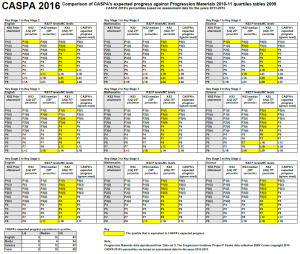We are asked this question sometimes from two perspectives:
- When discussing progress with an Inspector, Adviser, SIP, etc, how do CASPA’s expectations compare against Progression Materials’ expectations?
- When target setting, is CASPA’s expected progress enough?
To address these questions, we need to be able to compare CASPA’s expectations against another set of expectations, and we will use the Progression Materials quartiles when considering expected and challenging progress.
Before getting to the answer, we need to first remember that CASPA’s benchmarks describe expected progress; CASPA does not make a judgement about what might be challenging as this is different for each pupil, taking a range of factors into account.
In the Progression Materials quartiles tables, the median levels describe expected progress. Upper quartile levels have sometimes been used when target setting to challenge pupils and are sometimes referred to as describing challenging progress.
So the question is whether CASPA’s expected levels match Progression Materials’ expected levels. In answering this question, we took the most likely subjects (English, Maths and Science) and compared the two. The answer is very interesting – it is quite clear that CASPA’s expectations are nearly always significantly higher than those of the Progression Materials. In summary:
- For 88% of starting levels, CASPA’s expected level is the same as, or higher than, the upper quartile.
- 10% match median levels, and 2% match the lower quartile
It is worth exploring further the 2% that match the lower quartile. These are starting levels of P1(i) in English and Science for which the Progression Materials quartiles are based on a total of 3 and 7 pupils respectively. National Strategies and Ofsted both comment that there are small volumes of data used in Progression Materials…
For the full PDF table comparing CASPA and Progression Materials for English, Maths and Science, please click here.
We compared like with like for this comparison; Progression Materials quartiles do not take category of need into account so we also ignored category of need (Basis need = Ignore).
We tend to say “CASPA’s expectations” but since these expectations are reflecting the actual progress of pupils in many hundreds of schools, we could just as easily describe this expected progress as ‘the progress that actual pupils tend to make based on recent data over the last three years’.
The data set is based on a statistically significant sample data set from across a wide range of Special and Mainstream schools from most LAs in the country. CASPA 2016’s data set is based on results for summers 2013, 2014 and 2015 and therefore uses up-to-date data. CASPA users can obtain more details about the data set via the menu option Help | Guidance notes | CASPA’s comparative data.
CASPA 2016 note: There was one change to the table as a result of the update to CASPA’s data set based on the summer 2015 CASPA data collection. For KS2-KS3 in English, where the starting level is P1(ii), CASPA’s expected level moved from Upper Quartile to Median. In reality, this is not a dramatic change when you use sub-divisions as expectations previously were only just P3(i) so a very small decrease in the trend in rate of progress nudged the expected level just below the threshold. This in fact reversed what occurred last year which nudged the expected level up from P2(ii) to P3(i) so is merely a reflection of very small changes taking place on the boundary between two levels. There were a number of other small differences when considering sub-divisions of levels but only this starting point moved the expected level over a whole-level boundary.
To answer the original questions above…
- When reviewing achievement with Inspectors, the table (linked above) is set out in the same format used by Ofsted to help you illustrate how CASPA’s expected progress compares to Progression Materials upper quartiles, or higher, for the majority of starting levels.
- When target setting, you need to consider what selection you make for category of need, but we would still perhaps state the obvious; that it requires staff with detailed knowledge of the pupils to identify what is an appropriately challenging target. However, CASPA’s expectations will provide you with an excellent starting point to inform your decisions and, certainly if you ignore need, CASPA is most likely to be suggesting levels at, or above, Progression Materials’ upper quartile.
